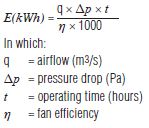The EN779:2012
Energy The society changes continuously. Environmental responsibility increases, work conditions are getting more important and technological developments are chasing each other rapidly. It is therefore that after 10 year the air filtrations’ most important norm is revised. Recently the European EN779 norm for course and fine dust is modified. It is expected that as from the first of January 2013 this norm will officially be accepted. To this respect we would like to inform you about the upcoming changes.
ISO16890 replaces EN779:2012
The ISO 16890 standard is LIVE and is the new global standard for testing and classification of air filters, and replaces the existing EN779:2012 norm. This new ISO 16890 standard is a big change in the way air filters are evaluated.
This new ISO 16890 test standard for air filters has been published in December 2016.
If you want to know more about our the new ISO16890 standard for air filters and PM1 protection, please don’t hesitate to contact us
Two biggest changes
With the new EN779:2012 norm a minimum testefficiency (MTE) is introduced for fine filters. During the EN779 performance test, the filters have to reach a minimal test effi ciency. This MTE, tested on particles of 0.4 micron, is set for fine filters to:
F7 > 35%
F8 > 55%
F9 > 70%
Direct effect of the MTE is that electrostatic synthetic filters will receive a lower classification as they have a lower efficiency after losing their electrostatic load.
F5 turns M5 and F6 turns M6
With the new EN779:2012 norm F5 will become M5 and F6 becomes M6. The letter M indicates a medium efficiency of the air filter. For this range of medium efficient filters there is no MTE, these filters however do have to pass their average efficiency (Em) of: M5 > 40 ≤ Em 60 ≤ Em < 80
What does this mean for you?
Range G1 till M6
The fi lters in the range of G1 till M6 will besides the name, not have any actual changes. You will be able to keep using the product as you are doing right now.
F7 and F9 filters
The filters in this range will have to commit to the new MTE. Many synthetic filters in these filtration classes will not pass the new standard and will have to be replaced with filters that does apply to the new standard.
The Eurovent energy labels are used as from the 1st of January 2012 by all Eurovent members with their G4 till F9 filters. Convenient for you, cause this enables you to select the desired energy classification and its corresponding usage. The energy labels only relate to those
filters that are in accordance with the new EN779:2012 and that are in the range G4 till F9 with a nominal debit of 3400m3/h. The energy label can be found on the quotation, the boxes, the filter frame, our website and catalog.
Classification
Filters in the range G4-F9 all have their own energy consumption determined by the applied dust concentration. The G4 filters are charged with 350g ASHREA dust, M5 and M6 with 250g ASHREA dust and the F7-F9 fi lters with 100g ASHREA dust. These quantities of ASHREA dust are determined based on a predicted dust amount dealt with by an average air handling unit. After the filters are charged with the standard dust amount, the energy labels are determined bases upon there theoretical energy consumption. The labels are classifi ed A to G. An A label being the most energy friendly.
The Calculation
The energy consumption is determined using the following equation:

The equation learns us that fi lters with a large fi lter surface are more energy economical than filters with a smaller filter surface. This usually also count for products with a high dust holding capacity. A bag filter will therefore always perform better than a panel filter.
Advantages-Direct savings
The energy label will provide information on the energy usage of the filter. The total cost of fi ltration are for 80% determined by energy cost. The better the energy label on the product (low energy consumption) the lower the energy cost during the total lifetime of the filter. It has been assumed that the fans are to run non-stop during the operating time of one year. The remaining data can be derived from the table above. These show that, in the event of fluctuating energy prices, the lower resistance yields savings on energy costs of over 600 euros. Even when the slightly higher purchase price of the filters is deducted from this sum, considerable savings are still made.
The message is therefore clear: When purchasing an air filter, one should consider not only the purchase price, but also the energy costs. AFPRO Filters would be pleased to advise you on such matters. Our sales staff and technicians collaborate in analysing the possibilities of cutting costs while maintaining air quality standards, by modifying the filter configuration.

Recognize an energy efficient filter directly.
Thanks to the introduction of the energy labels everybody can determine an energy efficient filter at sight. Sustainable entrepreneurship and energy saving have been simplified.
Guaranteed performance
The energy labels are independent certified by the Eurovent commission. This means that the filter performance is guaranteed. Manufacturers that are not part of the Eurovent committee are not entitled to use these energy labels. These producers use other labels which are not tested by Eurovent and therefore not have an independently tested certifi ed performance. Please note this when you make your purchase.



